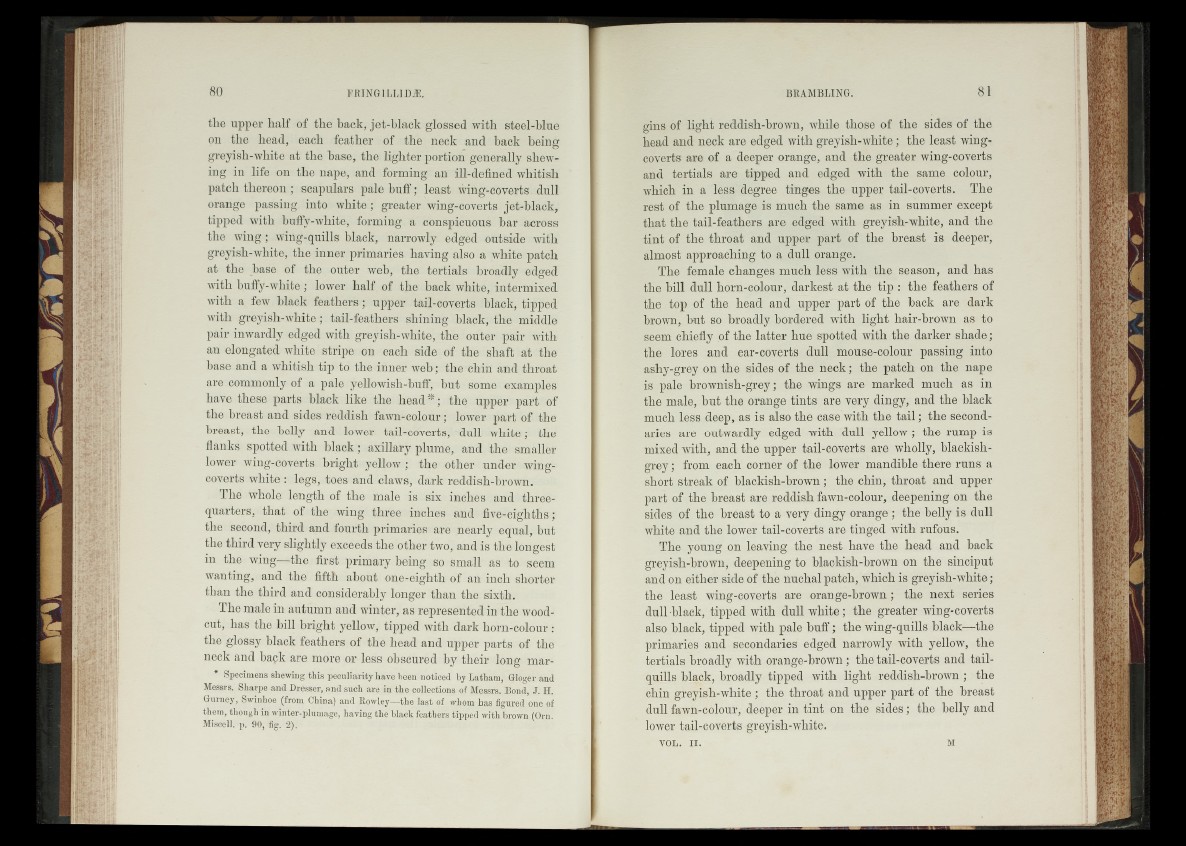
the upper half of the hack, jet-black glossed with steel-blue
on the head, each feather of the neck and back being
greyish-white at the base, the lighter portion generally shewing
in life on the nape, and forming an ill-defined whitish
patch thereon ; scapulars pale buff; least wing-coverts dull
orange passing into white ; greater wing-coverts jet-black,
tipped with huffy-white, forming a conspicuous bar across
the wing ; wing-quills black, narrowly edged outside with
greyish-white, the inner primaries having also a white patch
at the base of the outer weh, the tertials broadly edged
with huffy-white ; lower half of the back white, intermixed
with a few black feathers; upper tail-coverts black, tipped
with greyish-white; tail-feathers shining black, the middle
pair inwardly edged with greyish-white, the outer pair with
an elongated white stripe on each side of the shaft at the
base and a whitish tip to the inner web; the chin and throat
are commonly of a pale yellowish-huff, hut some examples
have these parts black like the head*; the upper part of
the breast and sides reddish fawn-colour; lower part of the
breast, the belly and lower tail-coverts, dull white; the
flanks spotted with black; axillary plume, and the smaller
lower wing-coverts bright yellow; the other under wing-
coverts white : legs, toes and claws, dark reddish-brown.
The whole length of the male is six inches and three-
quarters, that of the wing three inches and five-eighths;
the second, third and fourth primaries are nearly equal, but
the third very slightly exceeds the other two, and is the longest
in the wing—the first primary being so small as to seem
wanting, and the fifth about one-eighth of an inch shorter
than the third and considerably longer than the sixth.
The male in autumn and winter, as represented in the wood-
cut, has the bill bright yellow, tipped with dark horn-colour :
the glossy black feathers of the head and upper parts of the
neck and back are more or less obscured by their long mar-
* Specimens shewing this peculiarity have been noticed by Latham, Grloger and
Messrs. Sharpe and Dresser, and such are in the collections of Messrs. Bond, J. H.
Gurney, Swinhoe (from China) and Rowley—the last of whom has figured one of
them, though in winter-plumage, having the black feathers tipped with brown (Orn.
Miseell. p. 90, fig. 2).
gins of light reddish-brown, while those of the sides of the
head and neck are edged with greyish-white; the least wing-
coverts are of a deeper orange, and the greater wing-coverts
and tertials are tipped and edged with the same colour,
which in a less degree tinges the upper tail-coverts. The
rest of the plumage is much the same as in summer except
that the tail-feathers are edged with greyish-white, and the
tint of the throat and upper part of the breast is deeper,
almost approaching to a dull orange.
The female changes much less with the season, and has
the hill dull horn-colour, darkest at the tip : the feathers of
the top of the head and upper part of the hack are dark
brown, but so broadly bordered with light hair-brown as to
seem chiefly of the latter hue spotted with the darker shade;
the lores and ear-coverts dull mouse-colour passing into
ashy-grey on the sides of the neck; the patch on the nape
is pale brownish-grey; the wings are marked much as in
the male, but the orange tints are very dingy, and the black
much less deep, as is also the case with the ta il; the secondaries
are outwardly edged with dull yellow; the rump is
mixed with, and the upper tail-coverts are wholly, blackish-
grey ; from each corner of the lower mandible there runs a
short streak of blackish-brown ; the chin, throat and upper
part of the breast are reddish fawn-colour, deepening on the
sides of the breast to a very dingy orange; the belly is dull
white and the lower tail-coverts are tinged with rufous.
The young on leaving the nest have the head and back
greyish-brown, deepening to blackish-brown on the sinciput
and on either side of the nuchal patch, which is greyish-white;
the least wing-coverts are orange-brown; the next series
dull black, tipped with dull white; the greater wing-coverts
also black, tipped with pale buff; the wing-quills black—the
primaries and secondaries edged narrowly with yellow, the
tertials broadly with orange-brown; the tail-coverts and tail-
quills black, broadly tipped with light reddish-brown ; the
chin greyish-white ; the throat and upper part of the breast
dull fawn-colour, deeper in tint on the sides; the belly and
lower tail-coverts greyish-white.